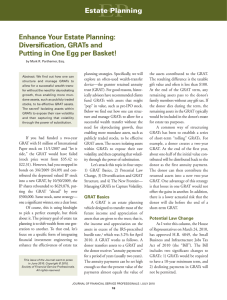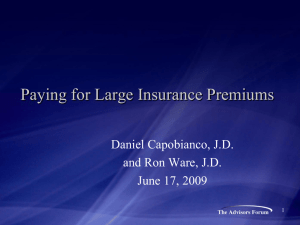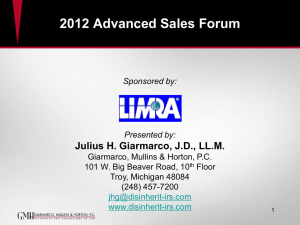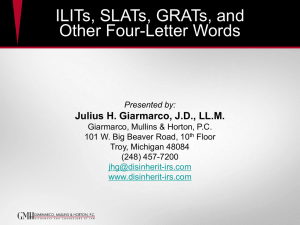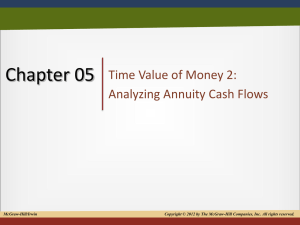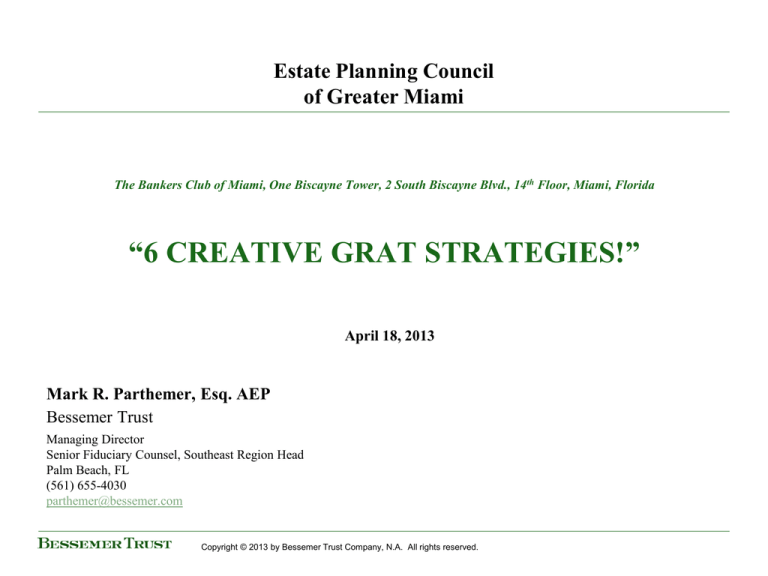
Estate Planning Council
of Greater Miami
The Bankers Club of Miami, One Biscayne Tower, 2 South Biscayne Blvd., 14th Floor, Miami, Florida
“6 CREATIVE GRAT STRATEGIES!”
April 18, 2013
Mark R. Parthemer, Esq. AEP
Bessemer Trust
Managing Director
Senior Fiduciary Counsel, Southeast Region Head
Palm Beach, FL
(561) 655-4030
parthemer@bessemer.com
Copyright © 2013 by Bessemer Trust Company, N.A. All rights reserved.
Thoughts on Tax Law
“The only difference between death and taxes is that death doesn't get worse every time Congress meets.”
- Will Rogers
“I like to pay taxes. It is purchasing civilization.”
- Oliver Wendell Holmes
“I am proud to be paying taxes in the United States. The only thing is I could be just as proud for half of
the money.”
- Arthur Godfrey
“The way taxes are, you might as well marry for love.”
- Joe E. Lewis
“There’s nothing wrong with the younger generation that becoming taxpayers won’t cure.”
- Dan Bennett
2
Administration’s Budget
Released April 10, 2013. Include:
1. Exemptions and rates to 2009 system...$3.5M and 45%.
2. Cap on short-term GRATs plus cap of length at life expectancy + 10 years; no
declining annuities.
3. 90 duration of GST exemption.
4. Eliminate HEET trusts by only permitting GST exemption for payment of health
and education expenses from individuals.
5. Grantor trust redux. Here again for the second time, but narrowed to focus on
installment sales to grantor trust.
6. Basis consistency.
3
Nearly zeroed-out Grantor Retained Annuity Trust
Step 1
Initial GRAT Funding
Returned to Grantor
$2,062,049
$2,000,000
Step 2
Annuity***
Year 1:
$937,295
Year 2:
$1,124,754
Amount transferred
$2,000,000
Value of annuity
$1,999,999 *
Value
of remainder
(Gift)
* Assumes
§7520 rate
of 2.00 %.
**
Assumes trust assets grow at 8%.
$1
*** Assumes 20% increase in annuity annually.
Step 3
Remainder after 2
years:
$197,798
(no gift tax)
(Grantor) Trust for Children
$197,798
Three Keys to Advanced GRAT Planning
•
Fundamental Determination: Optimal Term
•
Probability Analytics: Annuity
•
Free flip of the transfer coin: “Heads I Win; Tails I Get My Money Back”
–
Freeze technique, but
–
Advisors should “Wait” on GRATs…like a table server at a busy fine
dining establishment!
5
Understanding GRATs as a Freeze Technique
“Hypothetical” One-year 4% GRAT with 3% Return*
All value returns to grantor
4%
3%
Return to
Grantor**
* The hypothetical examples included in this presentation are for illustration only and are not projections of future returns, tax rates or exemption amounts.
** The hypothetical examples included in this presentation assume an Internal Revenue Code §7520 rate of 4.0%.
Often, Focus Is Only on Return
“Hypothetical” One-year
4%* GRAT with 10% Return**
10%
6%
Transfer To Next
Generation
4%
Return To
Grantor
4%
* The hypothetical examples included in this presentation are for illustration only and are not projections of future retur
** The hypothetical examples included in this presentation assume an Internal Revenue Code §7520 rate of 4.0%.
Portfolio GRAT: Flat versus Increasing Annuity —
Impact of Path Dependency
Three sample growth patterns of $1,000,000 investments
$1,610,00
0
175
150
125
100
75
50
25
0
Day 1
Steady-Eddy (10%)
Year 2
Year 3
Year 4
Beta One (20, 20, 4, 4, 4)
Year 5
End Yr 5
Beta Two (-20, -20, 36, 36, 36)
8
Path Dependency: Increasing Annuity Creates Benefit
5 year GRAT Results
9
1. Leveraged Mixed Asset GRATs
• Fund GRAT with discounted asset, hard-to-value asset or
alternative assets. Add fixed income portfolio.
• Use fixed income to fund annuity first.
•
Gives time for other assets to percolate.
•
Creates arbitrage between annuity based on partial discount yet
paid in non-discounted assets.
• To ease timing on funding and ease on transfer throughout,
drop hard-to-transfer assets (e.g., private equity) into an LLC.
10
Leveraged Mixed Asset GRAT
Step 1
Assets With Growth Potential
Create
Family
Entity
and
Trust
LLC
LLC Units
Fixed Income
Step 2
• Contribute LLC units and fixed income into GRAT.
• GRAT trustee first uses fixed income to satisfy
annuity payments.
Annuity
Payments
GRAT
• GRAT Remainder into Grantor Trust.
11
5 Year GRAT with 50% Private Equity and 50% Fixed Income
April 2013 7520 Rate
1.40%
Fixed Income/Yield
$ 1,000,000
3.00%
Private Equity/Growth
$ 1,000,000*
20.00%
$2,000,000
$1,800,000
$1,600,000
$1,400,000
* For illustrations
purposes, assumes
no valuation
discount.
Private Equity*
$1,200,000
$1,000,000
$800,000
$600,000
Fixed Income
$400,000
$200,000
$Initial
1
2
3
4
5
12
Bonus: Leveraged Mixed Asset GRAT with Loan
from GST Exempt Trust
Step 1
Assets With Growth Potential
Create
Family
Entity
and
Trust
LLC
LLC Units
Fixed Income
Step 2
• Contribute LLC units and fixed income into GRAT.
• GRAT trustee first uses fixed income to satisfy
annuity payments.
Loan
Annuity
Payments
GRAT
GST Exempt
Trust
• GRAT Remainder into Grantor Trust.
• Grantor Trust repays loan with LLC units.
13
2. Portfolio GRATs: Separate GRATs for Correlated
or Concentrated Positions
Diversification:
•
Prudent (Imperative) under Modern Portfolio Theory, but
•
Anathema to a Portfolio GRAT!
14
Portfolio GRAT: Asset Selection Not Enough
Return
Ending Value
1,000,000 @ $50 Company A
+20%
$60
$6,000,000
1,000,000 @ $50 Company B
-20%
$40
$4,000,000
$10,000,000
Minimum annuity to grantor*
Amount transferred to next generation
$10,140,000
–0–
* Assumes a 1.4% §7520 rate and for illustration and emphasis purposes only, a fictitious one year GRAT term.
15
Split Uncorrelated Assets into Separate GRATs
GRAT 1:
Company A
+20%
$60
$6,000,000
Minimum annuity to grantor*
$5,070,000
Amount transferred
$930,000
GRAT 2:
Company B
-20%
$40
$4,000,000
Minimum annuity to grantor*
Amount transferred
Total Transferred
$5,070,000
–0–
$930,000
* Assumes a 1.4% §7520 rate and for illustration and emphasis purposes only, a fictitious one year GRAT term.
16
3. Portfolio GRATs: Use Substitution Power to
Manage Performance
Resulting Raw Volatility Creates Likelihood of Greater Swings
Focus on Swings; Not Just Return over Term
Tactically Deploy Substitution Power to:
•
Lock-in Winners
•
Re-GRAT Losers
17
Portfolio GRAT:
Active Management via Substitution Power
Capture
intermediate
appreciation
Swap Zone!
Expected Volatility
8%
Time
Maturity
18
Portfolio GRAT: Active Management via
Substitution Power
Expected Volatility
8%
Why waste
reversion to
mean?
Swap Zone!
Time
Maturity
19
Case Study: $2,500,000 Portfolio GRAT
GRAT #1 - $380,000
GRAT #2 – Failed
GRAT #3 - $610,000
Total -
$980,000
If still original GRAT - Failed
20
4. “Shelf” GRATs
Four Risks to a Rolling GRAT Program:
1.
Donor dies.
2.
Assets decline in value.
3.
7520 rises dramatically.
4.
Law change prohibits new short term GRATs.
Shelf GRATS can mitigate risks #3 and 4.
21
4. “Shelf” GRATs
Step One: Create inventory of mid through longer GRATs.
Step Two: Fund currently with low volatile assets.
Step Three: Set on “Shelf” (but pay annuities).
Step Four (when needed): Swap in volatile assets to activate.
• Article April/May edition of Probate & Property.
22
Impact of Minimum 10 Year Term
7520 Rate
1.40%
Annuity Growth
20%
10
9
8
7
6
5
4
3
2
1
4.24%
5.24%
6.53%
8.26%
10.65%
14.08%
19.35%
28.29%
46.44%
2
5.09%
6.28%
7.84%
9.92%
12.78%
16.89%
23.22%
33.95%
55.73%
3
6.10%
7.54%
9.41%
11.90%
15.33%
20.27%
27.86%
40.74%
4
7.32%
9.05%
11.29%
14.28%
18.40%
24.33%
33.43%
5
8.79%
10.86%
13.55%
17.13%
22.08%
29.19%
6
10.55%
13.03%
16.26%
20.56%
26.49%
7
12.66%
15.63%
19.51%
24.67%
8
15.19%
18.76%
23.41%
9
18.23%
22.51%
10
21.87%
First 5 years:
31.54%
23
Why Prohibit “Front-Loading” of Annuity
7520 Rate
1.40%
Annuity Growth
-50%
10
9
8
7
6
5
4
3
2
1
51.44%
51.49%
51.58%
51.77%
52.15%
52.94%
54.63%
58.40%
67.91%
2
25.72%
25.74%
25.79%
25.88%
26.07%
26.47%
27.31%
29.20%
33.96%
3
12.86%
12.87%
12.90%
12.94%
13.04%
13.24%
13.66%
14.60%
4
6.43%
6.44%
6.45%
6.47%
6.52%
6.62%
6.83%
5
3.22%
3.22%
3.22%
3.24%
3.26%
3.31%
6
1.61%
1.61%
1.61%
1.62%
1.63%
7
0.80%
0.80%
0.81%
0.81%
8
0.40%
0.40%
0.40%
9
0.20%
0.20%
10
0.10%
First 3 years:
90.02%
24
5. Leveraged GRAT Combined with Sale
Transaction.
Concept: Client with investment FLP sells and contributes LP
units and other assets (e.g., fixed income) to an LLC;
(Discounted) Sale price paid with a Note; Note contributed into
a GRAT.
•
Leveraged GRAT (Strategy #1) effective, plus may serve as
revaluation buffer.
•
Extraordinary leverage if Note interest can fully fund GRAT
annuity payments.
•
Consider SCIN.
25
Leveraged GRAT with Sale
Assets With Growth Potential
Step 1
FLP
LP Units
Create
Investment
FLP.
Step 2
Step 3
Fund GRAT
with Note.
• Client contributes and sells LP units
plus other assets to LLC.
• LLC pays with a Note.
• Could be a SCIN.
LLC
GRAT annuity
funded with Note
interest.
GRAT
• GRAT Remainder into Grantor Trust.
26
6. Derivatives with GRATs
Some contribute derivatives into GRATs.
There also is an ability to have the GRAT use them.
All entail friction costs and must be justified by whatever enhancement may
result to the probability of transferring more value (or cap ultimate transfer).
27
One of Two Counter-party Options
Public versus Private
Private hedge transactions may minimize costs.
Use of grantor’s spouse may avoid reciprocal trust issues and income taxation:
•
Sales between spouses tax free under section 1041.
•
Sales between grantor trust and grantor’s spouse tax free. PLR 8644012; PLR
20012007.
28
Derivative Example #1: Sell an Out-of-the- Money Option.
Grantor’s spouse (or other party) purchases from the GRAT an out-of-the-money - call
option with a strike price that is higher than the market price.
Option priced via Black-Scholes or other binomial model. Rev. Proc. 98-34.
Example: Assume that for a $10 Stock, a $12.50 option sells for $3.29.
Result:
1.
Success: Stock rises above $12.50, remainder beneficiaries receive benefit of 25%
return ($12.50/share) plus 32.9% option return ($3.29/share), less §7520. Balance of
upside reverts to grantor’s spouse.
2.
Success: Stock does not exceed $12.50, remainder beneficiaries receive actual growth
plus option return of $3.29, less §7520.
3.
Success: Stock remains at $10, GRAT has $13.29/share and remainder beneficiaries
receive $3.29, less §7520.
4.
Success or Failure: Stock drops below $10, remainder beneficiaries receive excess, if
any, of reduced value plus $3.29, less $10 and less §7520. (If 7520 were 0%, stock
could drop to $6.72 and GRAT still would be (barely) successfully.)
29
Derivative Example #2: Purchase an At-the-Money Option.
GRAT purchases at-the-money call option (option's strike price is identical to the price of the underlying
security). This provides GRAT right to future growth, if any.
Example: GRAT owns 100 shares trading at $100 per share. Trust purchases option on 100 shares at
$100.
Result:
Success: Remainder beneficiaries receive double on growth, if any, less cost of option and
less §7520.
Failure: GRAT will fail if stock price goes down, remains flat or is up negligible amount
(not enough to offset cost of option plus §7520).
30
Derivative Example #3: Covered-call Combination.
Potential to double gain on modest growth stocks, with little to zero net cash cost. Achieved by giving up
excess growth.
GRAT:
•
•
Purchases an at-the-money option, and
Sells an out-of-the-money call option.
Use strike price or limit number of shares so net no cost to GRAT.
Example: GRAT owns 100 shares trading at $100 per share. Trust purchases option on 100 shares at $100
(same as Example #2). Further, GRAT sells option on 200 shares at $120 per share.
Result:
Success: Assuming cost of options net to zero, remainder beneficiaries receive
double on growth from $100 to $120, but nothing on growth above $120, less §7520.
Failure: GRAT will fail if stock price goes down, remains flat or growth on 200 shares is
less than §7520.
31
Simplified GRAT Payoff Chart (7520 @ 0%)
Share Price
Lower
GRAT Succeeds
Funding Value
GRAT Fails
Share Price
Higher
Stock
Price
32
Impact of selling a “Covered Call” Strategy
Share Price
Lower
Receive Premium for
Agreeing to cap return
Share Price
Higher
Stock
Price
33
Payoff Chart of GRAT with “Covered Call”
Return is capped
Share Price
Lower
Share Price
Higher
Stock
Price
34
One More Thought on Tax Law
“Why does a slight tax increase cost you two hundred dollars and a substantial tax cut save you thirty
cents?”
- Peg Bracken
35
36


